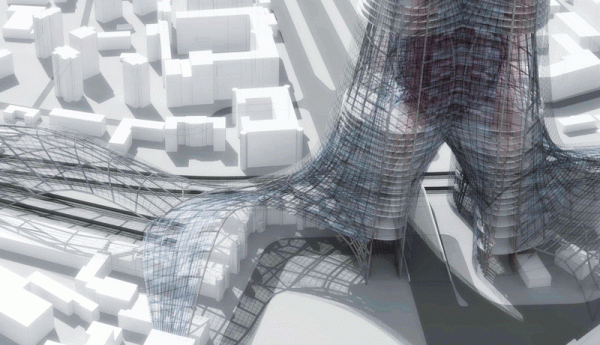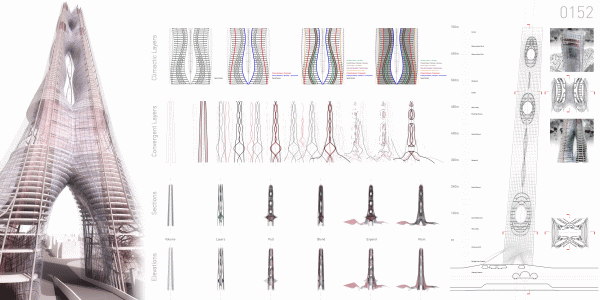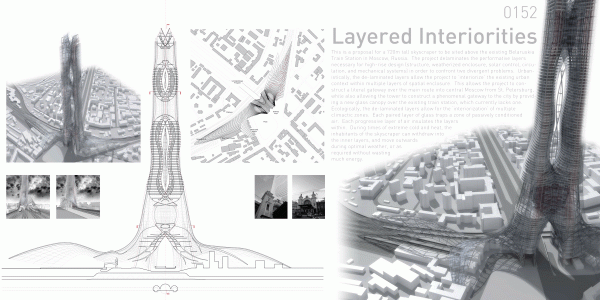1st Place
2008 Skyscraper Competition
Elie Gamburg
United States
This is a proposal for a 720m tall skyscraper to be located above the existing Belarussky Train Station in Moscow, Russia. The program consists of a hotel, assembly, retail, cultural spaces, and apartments. These respond to the needs of the site, which serves as a major gateway to Moscow by road and rail. The main road to St. Petersburg runs through the site and is intersected by the main train line to Europe. Built in 1870, Belarussky Train Station is one of Moscow’s most important historical structures. It was celebrated throughout its history and earned the moniker ‘victory station’ for its role in shuttling Soviet troops to the German front during WWII, and for receiving the first trainloads of soldiers returning victorious after the war.
The process of designing a skyscraper for this site faced two problems above and beyond the issues typically confronted by skyscrapers, built above complex interchanges of roads, rails, and subways. Firstly, the building needed to address multiple urban contexts which varied drastically in their history, form, and program. Secondly, the design needed to confront the environmental difficulties of building in Moscow’s harsh climate. The solution proposes to de-laminate the performative layers necessary for skyscraper construction (structure, weatherized enclosure, solar control, circulation, and mechanical systems), in order to solve these divergent problems. The de-laminated layers are programmed with technical functions and then interwoven amongst each other. Most spatial conditions are defined as the spaces between (and serviced by) these layers, but at key juncture points (programmatically and structurally) the layers interweave forming more complex spaces.
Urbanistically, the de-laminated layers ‘interiorize’ the existing urban context within multiple levels of spatial enclosure. As the building approaches the ground, it splits to form a literal gateway over the city’s main street. At the same time, several of the layers pass over Belarussky Station to form a glass canopy above the tracks, while also helping to preserve the existing building. Other layers pass over the existing ‘object building’ modern context elsewhere in the site, turning the otherwise useless expanses of open space between those buildings into partially weatherized, and thus usable, public space.
Ecologically, the de-laminated layers allow for the ‘interiorization’ of multiple climactic zones. Each of the layers traps a zone of passively conditioned air. Each progressive layer of air insulates the layers within, meaning each layer takes progressively less energy to heat or cool. During the winter, the outer layers function as greenhouses, heating the inner ones. During the summer, the heat generated by the outer layers generates a stack effect – the rapidly rising air aids in passive ventilation and cooling. As a result, the building responds sectionally to its climate. During times of extreme cold and heat, the inhabitants of the skyscraper can withdraw into the inner layers, while at other times they can freely use the interstitial spaces between the layers. For special needs, each hotel or apartment occupant can choose, as required, to expend the extra energy needed to condition their share of the interstitial spaces, meaning that their domesticated space can ‘expand’ or ‘contract’ as they need as well.
















